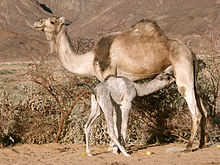Camel (color)
Appearance
| Camel | |
|---|---|
| Hex triplet | #C19A6B |
| sRGBB (r, g, b) | (193, 154, 107) |
| HSV (h, s, v) | (33°, 45%, 76%) |
| CIELChuv (L, C, h) | (66, 47, 52°) |
| Source | ISCC-NBS |
| ISCC–NBS descriptor | Light yellowish brown |
| B: Normalized to [0–255] (byte) | |

Camel is a color that resembles the color of the hair of a camel.
The first recorded use of camel as a color name in English was in 1916.[1]
The normalized color coordinates for camel are identical to fallow, wood brown and desert, which were first recorded as color names in English in 1000,[2] 1886,[3][a] and 1920,[5] respectively.
Fashion
[edit]Camel is the color of a specific type of overcoat known as a polo coat or camel-hair coat. In a 1951 Collier's magazine fashion article, it is said camel colored polo coats are proper to wear in the summer, in the country and in the U.S. South, but navy blue overcoats are proper to wear in the city and in autumn, winter and spring.
See also
[edit]Notes
[edit]- ^ After recording "wood brown" in his 1886 book, Robert Ridgway further refined the details of its color coordinates in his 1912 publication.[4]
References
[edit]Bibliography
[edit]- Maerz, Aloys John; Paul, Morris Rea (1930). A Dictionary of Color. New York: McGraw-Hill Book Company. LCCN 30016563. OCLC 1150631.
- Ridgway, Robert (1886). Nomenclature of Colors for Naturalists, Compendium of Useful Knowledge for Ornithologists. Boston: Little, Brown and Company. OCLC 768502.
- Ridgway, Robert (1912). Color standards and color nomenclature. Washington, D.C.: Robert Ridgway. LCCN 13007093. OCLC 630954.
Citations
[edit]- ^ Maerz & Paul, p. 191; Color Sample of Camel: p. 49 Plate 15 Color Sample A6
- ^ Maerz & Paul, p. 195; Color Sample of Fallow: p. 47 Plate 12 Color Sample B5
- ^ Ridgway (1886), pp. 36, 54, 117; Color Sample of Wood Brown: Plate III fig. 19
- ^ Ridgway (1912), p. 40; Color Sample of Wood Brown: Plate XL
- ^ Maerz & Paul, p. 203; Color Sample of Desert: p. 47 Plate 12 Color Sample I7

